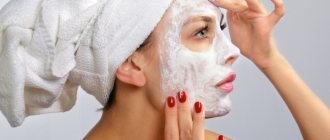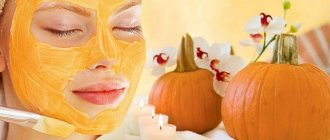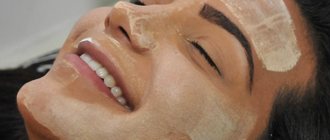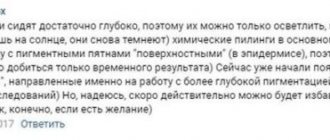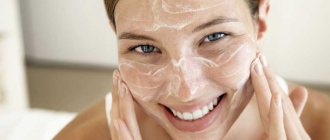Are there any benefits to scalp exfoliation?
The benefits of cleansing the scalp are undeniable. Thanks to the mechanical and chemical effects of special products on the skin, deep cleaning of pores and saturation of tissues with oxygen occurs, which has a beneficial effect on hair growth and helps strengthen it.
Main benefits of peeling:
- removal of contaminants;
- removal of sebaceous gland derivatives;
- removal of cosmetic residues;
- improving blood circulation;
- increasing the tone of the scalp;
- stimulation of cellular metabolism;
- deep nutrition of hair follicles in the future;
Scalp peeling is an excellent procedure that improves the condition of the skin and hair. - acceleration of hair growth.
Types of scalp peeling that can be done at home
There are several types of peelings, each of which differs in nature and method of implementation. Most types of procedures are carried out in a beauty salon.
There are the following types of peeling:
- mechanical;
- chemical;
- gas-liquid (hardware).
In turn, chemical peels are divided into:
- fruit;
- enzymatic;
- biological.
Hardware peeling includes:
- galvanic peeling;
- aqua peeling;
- ozone peeling.
Of all the possible options, mechanical and fruit peeling can be done at home. Mechanical peeling - cleansing the scalp using products with abrasive particles (scrub or gunnage). In addition to solid particles, peels usually include vitamin and mineral complexes.
Therefore, the procedure not only cleanses the upper stratum corneum, but also promotes deep nourishment of the skin. The procedure takes the form of a relaxing scalp massage using a scrub that is rubbed into the area of the hair follicles.
Fruit peeling is classified as chemical. Its essence lies in the use of a mixture of fruit and synthetic acids, which have a gentle effect on the scalp and cleanse it. The mixture can be purchased at the store or prepared yourself using a paste made from fruit.
Peeling with sea salt and colorless henna
For peeling salt, you need to take sea salt and medium grinding, so that there are particles that you will scrub. It is better to take Iranian colorless henna; it has excellent quality and strengthening properties.
Olive oil penetrates into the hair follicle and scalp cells, that is, it nourishes the hair with beneficial substances from the inside, and the oil also well envelops the hair shaft itself and thanks to this the hair structure improves. It is the most popular base oil in hair care and can be applied to the scalp.
Vitamin C - promotes cell renewal, increases blood flow, and helps with hair loss.
- 2 tablespoons salt;
- 1 tablespoon of colorless henna;
- 2 ampoules of vitamin C;
- olive oil.
Add henna and olive oil to the salt, about a spoon, so that the mixture is thick and at the end, just before application, add vitamin C.
Peculiarities of peeling according to skin type
Each hair type has its own nuances in care. Therefore, to achieve maximum effect, you should choose the type of procedure depending on the characteristics of your hair.
Fat
Oily scalp is characterized by excessive production of subcutaneous sebum. Peeling for this skin type requires a careful preparatory stage, otherwise the effect of the procedure will be minimal. Before peeling, it is necessary to cleanse the skin of sebaceous contaminants using a scrub and only then proceed with the necessary manipulations.
Dry
When choosing the type of peeling for dry skin, you should give preference to components that will not overdry it.
You should also limit the number of procedures performed. It is recommended for those with dry hair and skin to carry out the procedure no more than once every 10 days. After the course, a two-month break is required and can be repeated again.
Sensitive
For those with sensitive scalp, you need to be careful when carrying out the cleansing procedure. It is necessary to select the most gentle compositions of peeling complexes so as not to harm the skin.
Most often, peelings based on fruit acids or hardware peels are used in a beauty salon. It is not recommended to carry out the procedure more often than once a month.
For hyperkeratosis
Skin hyperkeratosis is a pathological thickening of the skin resulting from untimely exfoliation of keratinized cells. Peeling for hyperkeratosis should be more aggressive in order to achieve the maximum effect of the procedure.
Chemical peels are best suited for this purpose, the effect of which is similar to the natural regeneration process. Peeling gently but deeply affects the skin and promotes cleansing without the risk of damage.
Are there any contraindications and side effects?
There are a number of contraindications for peeling. Among them are direct (when the procedure is strictly prohibited) and relative (can be done with caution) contraindications.
Strict contraindications include:
- violation of the integrity of the skin (wounds, scratches, cracks);
- skin infections;
- many moles on the head;
- papillomatosis;
- the presence of neoplasms of unknown origin;
- allergy;
- diabetes.
Indirect contraindications are:
- pregnancy;
- breastfeeding (lactation);
- hypertonic disease;
- severe baldness;
- hypersensitive skin;
- mental disorders.
Attention! We recommend that you consult a doctor before undergoing peeling.
How to peel correctly
Scalp peeling requires careful preparation and compliance with all necessary stages.
Main details of the procedure:
- peeling is carried out on damp hair before washing your hair with shampoo;
- The peeling agent is applied exclusively to the root zone;
- application of the solution to cleanse the skin is carried out using light massage movements;
- purchased peeling products are used exclusively in accordance with the instructions indicated;
- rinsing hair after the procedure is carried out using warm, not hot water;
- a feeling of discomfort during peeling is the reason for stopping the procedure as soon as possible.
Contraindications
Contraindications for use:
- It is not recommended to peel if the skin is dry and sensitive;
- if there are cracks or wounds on the head;
- not recommended for heavy hair loss;
- if you have cancer, it is better to consult a doctor before use;
- in case of cerebral circulatory disorders;
- for infectious skin diseases.
If you have any of the listed symptoms, then peeling is highly undesirable.
Cosmetics for scalp peeling. Review, instructions, prices
Due to the popularity of the peeling procedure, today's market offers a wide range of products designed to cleanse the skin and regenerate skin cells. Below are the most famous manufacturers of scalp peelings.
Nioxin regenerating peeling
Regenerating peeling NIOXIN from an American manufacturer has gained wide popularity due to its mild skin cleansing properties. The product consists of natural ingredients and saturates the skin with essential nutrients. The peeling composition includes plant extracts, oils, acids, cane and maple sugar, and aloe.
The product is intended for professional care in a salon, but if you carefully study the instructions, it can be used at home.
Instructions for using peeling:
- Distribute hair parting into 5-7 parts.
- Using a brush, apply the product to the root zone of the hair.
- Rub the product into the skin.
- After a quarter of an hour, wash off the composition with shampoo.
Repeat the procedure no more than once every 30-45 days. Cost of the product: from 743 rubles.
Lebel
The Japanese brand Lebel Cool Orange is designed to cleanse the scalp and is presented in the form of a transparent gel without scrubbing particles. Its action is aimed at normalizing the functioning of the sebaceous glands, deep skin regeneration and accelerating hair growth.
Includes:
- orange;
- peppermint;
- jojoba oil;
- chamomile;
- bamboo root.
Peeling stages:
- The product must be applied to slightly damp hair, parted in the root area.
- Leave on the skin for 5 minutes and remove any remaining product with water.
- Repeat the procedure every week.
The product has 2 packaging volumes - 130 and 240 g. The cost of the minimum volume is from 1500 rubles.
Ollin
Ollin Full Force with bamboo extract - peeling from a Russian brand. Due to the absence of scrubbing particles, peeling helps cleanse the skin of impurities and normalize the functioning of the sebaceous glands. The product contains bamboo extract, silicon dioxide, and a special Seborami complex.
Instructions for use:
- Lightly moisten hair and distribute into partings.
- Apply the product to the scalp, rinse after 3 minutes.
- Repeat the procedure once a week.
Average cost: from 540 rub.
Teotema
The Italian product Teotema is suitable for those with brittle and weakened hair. The product cleanses the skin, fights dandruff, accelerates skin metabolic processes and strengthens the hair structure.
Includes:
- tea tree oil;
- jojoba;
- burdock and bitter almond extracts;
- salicylic acid and allontoin are a component of natural origin with anti-inflammatory properties.
How to use peeling: rub the product into the scalp with light massaging movements. Remove residues with water and hair detergent after 3 minutes. Repeat cleansing twice a month. Cost: from 1100 rub.
Don't miss the most popular article in the section: Amaranth oil - properties and use in cosmetology, reviews, price of the product.
Utena reibi peeling gel
Peeling gel Reibi UTENA from a Japanese manufacturer cleanses pores of impurities, improves blood flow, which promotes activation of hair follicles and further hair growth. The product contains wild orange, Japanese angelica and calamus oils. Designed for lifeless and dry skin.
Directions for use: Apply the product with gentle pats to the scalp. Remove the product with shampoo after 3 minutes. Average cost: from 900 rub.
Paul Mitchell
Paul Mitchell Tea Tree deeply moisturizes the scalp and removes dead skin particles from its surface. Manufacturer: USA.
The gel contains natural ingredients:
- chamomile and lavender flowers;
- mint leaves;
- rosemary;
- jojoba oil;
- peppermint oil.
Application of peeling: apply the product to pre-moistened hair, distributing it along the partings.
After 3-5 minutes, rinse with warm water and shampoo. Cost of the product: 1900 rubles.
L`Oreal
Serioxyl L'Oreall is an abrasive peeling based on glycolic acid. Suitable for brittle and weakened hair. Gently removes impurities, increases blood flow and accelerates hair growth. Contains menthol and Omega-6 derivative. Available in the form of 15 ml capsules (15 pcs.) The product must be kept on the scalp for about 3-5 minutes and rinsed off with warm water.
Schwarzkopf
Pre-Shampoo Peeling from Schwarzkopf Professional is a universal product for all skin types. A soft gel with abrasive particles removes subcutaneous sebum and impurities from the top layer of skin. Peppermint extract gives tone to the epidermis and normalizes pH balance. Peeling is used only on damp hair. The procedure time is 3-5 minutes. Average cost 500 rub.
Natura Siberica
Sea buckthorn scrub from the Russian brand Natura Seberika is suitable for any skin type, cleanses the top layer of dead skin cells and strengthens hair follicles. The product is effective in combating dry skin and dandruff. The natural composition includes sea buckthorn oil, calendula and Siberian mint extract.
The product is applied to damp skin in the area of the hair roots. Procedure time: 3-5 minutes. Product price: 300 rub.
Pharmacist
The product of the Apothecary line from the Vitex brand with apricot kernels is designed to exfoliate dead particles from the scalp. Helps improve blood circulation, which leads to increased hair growth and the appearance of a healthy shine. Available in the form of 10 ml capsules for single use.
How to use the product: apply peeling to damp hair, rub into scalp for 5 minutes. Wash off with water and shampoo. Average price: 540 rub. per pack 10 pcs. (10 ml).
Scalp peelings using folk remedies
Despite the effectiveness of professional peeling products, you can achieve the desired effect by using homemade scrubs. The most effective of them are presented below.
Salt scrub
Salt scrub is a type of mechanical peeling. Solid salt particles help cleanse the scalp of dead skin and styling product residues. You can use regular salt or sea salt for scrubbing. To improve the effect, salt is combined with various substances: blue or white clay, essential and base oils, red pepper or kefir.
Salt is used for oily skin types or the presence of seborrheic dermatitis. Frequency of cleansing: once every 7 days.
Coffee scrub
In order to prepare a coffee scrub, you need natural ground coffee, which cleanses the skin thanks to its small particles. A scalp massage using a coffee scrub improves blood circulation, which allows the hair follicles to receive active nutrition and accelerate growth in the future.
To achieve maximum effect, coffee is combined with oils, red pepper, egg yolk or sea salt. For dry skin, it is enough to carry out the procedure once every 2 weeks. Coffee-based cleansing is used for brittleness, dryness and dandruff.
Soda scrub
Soda peeling is a chemical peel, so it requires special care when performing. Soda perfectly fights skin impurities, acting as a sorbent that draws sebum from clogged sebaceous glands. You can combine soda with sea salt and lemon juice. Soda peeling is suitable for oily skin that gets dirty quickly.
Cleansing with baking soda is not recommended for those with dry or damaged skin. Soda peeling should be repeated once every 10 days.
Sugar scrub
Scalp exfoliation using sugar effectively removes impurities from the pores. During the procedure, small sugar particles will gradually dissolve, which significantly reduces the risk of skin damage. The procedure is suitable for all skin types.
Sugar acts as an abrasive base, to which base and essential oils, fermented milk products, honey, spices, herbal decoctions or infusions are added.
For the procedure, regular or cane sugar is used. Sugar peeling should be done once every 2 weeks.
Homemade peeling with sea salt and clay
Clay should be chosen depending on the condition of your scalp:
Blue clay - used for hair loss, to accelerate hair growth, it also nourishes the hair from the inside and prevents fragility.
Green clay ˜– helps get rid of dandruff and seborrhea of the scalp, reduces the activity of the sebaceous glands, strengthens hair, recommended for oily hair prone to dandruff.
White clay - used for hair loss, as well as to strengthen and restore hair and scalp. Suitable for thin, depleted and damaged hair.
Pink clay - suitable for sensitive scalp, gently cleanses hair and scalp, relieves irritation, improves microcirculation, prevents hair breakage.
Gray clay - used for brittle, split ends, it also takes good care of the scalp, prevents flaking of the scalp, and accelerates hair growth.
- 2 tablespoons sea salt;
- 1 tablespoon of clay (blue, green, white, pink, gray);
- milk;
- 5-8 drops of essential oil or rosemary, orange, washed...
Pour salt and clay into a glass bowl, dilute the essential oil in milk and then add it to the rest. You need to add enough milk so that it becomes a thick, viscous mixture.
Peeling recipes
A variety of recipes allows you to prepare a scalp peeling product that will combat a specific problem or set of problems associated with hair growth and damage.
For hair loss
The main function of peeling used against hair loss is to strengthen and nourish the hair follicle. A salt scrub with added oils is suitable for this purpose.
To prepare it, you need to take:
- medium table salt – 40 g;
- burdock oil – 30 ml;
- orange essential oil – 2-3 drops.
Mix all ingredients in a separate container. Part your hair into 6-8 parts and apply a scrub, thoroughly but gently rubbing abrasive salt particles into the scalp. Massage for 3 minutes, rinse off any remaining product using shampoo. Repeat the procedure once every 7-10 days.
For fast hair growth
For rapid hair growth, peeling using powdered red pepper or cinnamon is suitable, which helps to increase blood circulation and nourish the hair roots.
To prepare the product, you need to take:
- 20 g sea salt;
- 5 g hot red pepper powder;
- 5 g cinnamon;
- 10 ml of any base oil.
Mix all ingredients until a thick paste is obtained. Apply the mixture to damp hair and gently rub into the scalp. As soon as a burning sensation appears, wash off the solution with shampoo. The procedure must be carried out once a week.
Anti-dandruff
When fighting dandruff, the main task of peeling is to moisturize dry scalp. A scrub that uses sugar, base and essential oils works well for this purpose.
To prepare an anti-dandruff sugar scrub, you need:
- 40 ml of any shampoo;
- 80 g cane sugar;
- 2 drops of any essential oil;
- 20 ml olive oil.
Mix all ingredients into a thick mixture. Moisten your hair, part it into 6 parts and apply the resulting product. Rub into the scalp for about 2-3 minutes, and then rinse with water and shampoo. Repeat the procedure every 10 days.
From fat content
Peeling to prevent excessive oiliness of the scalp must be prepared using soda. The substance helps cleanse the skin of impurities caused by the active work of the sebaceous glands.
To prepare a scrub for oily skin types, you need to:
- 20 g soda;
- 30 ml water.
Mix soda with water. Apply to damp hair in the hair follicle area. Massage your head with light massage movements. Wait 3-5 minutes and rinse off the remaining mixture with warm water and shampoo. To avoid drying out the scalp, the procedure should be repeated no more than once every 10-14 days.
For dryness
Mix the scrub ingredients to a thick paste. Apply the mixture to damp hair and leave for about 3 minutes. Remove any remaining scrub using warm water. Repeat scrubbing 1-2 times a week.
To prepare a coffee scrub you will need:
- coffee grounds – 30 g;
- 1 egg yolk;
- liquid honey - 20 ml;
- orange or tea tree essential oil – 3 drops.
The ingredients of the scrub should be mixed to a thick paste. Pre-wet your hair with water, apply the mixture to the scalp and massage it for 3 minutes. Remove any remaining scrub from the scalp with warm water. Repeat scrubbing 1-2 times a week.
WHAT IS SALT HAIR CLEANSING
Salt peeling for hair is an effective means for exfoliating and removing impurities, in which salt crystals are the main abrasive substance. This type of exfoliation is superficial and affects only the uppermost layer of the epidermis. However, this is enough for the surface of the head, but deeper effects can be harmful.
5 advantages of salt peeling
Salt has always been valued for its beneficial qualities. However, if a thousand years ago it was worth its weight in gold, today you can buy it in any store, and every home probably has packages “in reserve.”
Salt peeling for skin has many beneficial properties:
- Removing dead cells allows you to heal and rejuvenate the skin, improve oxygen saturation;
- Massage - activates blood circulation, which improves nutrition of hair follicles;
- Nutrition - salt is rich in nutrients;
- Antibacterial properties - disinfects, blocking inflammatory processes;
- Drying - compensates for the increased activity of the sebaceous glands.
We recommend: 10 ENZYME PEELINGS that you should try at home
In its natural state, salt is a crumbly substance that cannot remain on the surface of the body on its own. So for ease of use, the salt powder is mixed with some kind of binder:
- Water - does not have pronounced beneficial properties, it simply gives the mixture the necessary consistency;
- Vegetable oils (olive, almond, jojoba, avocado, wheat germ, pumpkin) - moisturize and nourish the skin, and also dissolve salt crystals much more slowly than water or kefir;
- Kefir - helps relieve irritation, restores elasticity, moisturizes;
- Shampoos, balms and masks allow you to combine exfoliation and care with the help of professional cosmetics.
In addition to the binder, the composition may contain other active ingredients, such as soda, herbal extracts and essential oils. Essential oils are diverse and, in addition to pleasant odors, have various functions:
Table of beneficial properties of essential oils for the beauty of curls
| ACTION | ESSENTIAL OILS |
| Hair restoration | Conifers, rosemary, cinnamon |
| Reduced fat production | Citrus, tea tree, rosemary, lemon balm, mint, cedar |
| Hydration | Jasmine, lavender, rose, sage, myrrh, chamomile, ylang-ylang |
| Prevention of dandruff | Lavender, tea tree, citrus, geranium, rosemary |
How often can you exfoliate your head?
Scalp peeling is not suitable for daily care and is carried out within a strict time interval.
How often you need to scrub your scalp depends on 2 factors:
- type of peeling;
- skin and hair type.
| Mechanical peeling | It is carried out once a week for oily skin types, or once every 14 days for those with dry and sensitive skin. |
| Chemical peeling | Salon peeling is carried out at intervals of 2-2.5 months. Peeling using special cleansing products at home is carried out once every 7 days. |
| Hardware peeling | Carried out in courses. A minimum of 4 sessions are required, 10 days apart. After a 3-month break, the course can be repeated again. |
Peeling is a procedure popular not only for the face, but also for the scalp. Peeling actively fights impurities, sebum secretion and residues of care products. It is an important cleansing step before using shampoos and conditioners; it helps strengthen hair and activate its growth.
Article design: Oleg Lozinsky
HOW IT’S DONE IN THE SALON
Sometimes the doctor will advise you not to limit yourself to home recipes, but to carry out exfoliation in a specialized salon, where professional-grade substances and special equipment are used.
Salon head peeling is used mainly when aesthetic problems go beyond the scope of treatment at home and the help of a trichologist is required. That is, in this case we are not talking about a hairdresser, but about a clinic with specialist dermatologists, cosmetologists, and trichologists working there.
Salon stages:
- PREPARATORY . Includes mandatory hair washing. It is necessary to make sure that there are no cracks or wounds on the skin. The strands are divided into several equal parts for ease of application.
- DEFEATING . At this stage, it is necessary to normalize the pH level in order to create an environment unfavorable for bacteria.
- APPLICATION OF EXFOLIANT (chemical, mechanical, hardware).
- NEUTRALIZATION is carried out after 10-20 minutes, depending on the procedure protocol (with water or solution).
- SOOTHING/NOURITING MASK.
- DRYING , conditioning.
For a hairdresser, doing a hairstyle on a head that has just undergone a skin cleansing process is not work, but a pleasure.
The hair was saturated with moisture, the ends became elastic and solid. In such conditions, any styling lasts a long time, the curls are shiny and springy, and the shape of the hairstyle is put in order with just a light shake.
If haircut and styling involve coloring, then skin cleansing is carried out only using gentle methods: low concentration acidic or enzymatic. After washing off their components, any paint will lay flat and stable.
How often to carry out
Hair peeling performed in the salon allows you to plan your next visit no earlier than in 1-2 months, provided there are no pathologies or serious dermatological diseases.



